A comprehensive guide to the Central Limit Theorem covering convergence to normality, standard error, sample size requirements, and practical applications in statistical inference. Learn how CLT enables confidence intervals, hypothesis testing, and machine learning methods.

This article is part of the free-to-read Data Science Handbook
Choose your expertise level to adjust how many terms are explained. Beginners see more tooltips, experts see fewer to maintain reading flow. Hover over underlined terms for instant definitions.
Central Limit Theorem: The Foundation of Statistical Inference
The Central Limit Theorem (CLT) is one of the most fundamental results in probability theory and statistics. It states that the distribution of sample means approximates a normal distribution as the sample size becomes larger, regardless of the population's original distribution. This remarkable property underpins much of statistical inference and hypothesis testing.
Introduction
The Central Limit Theorem represents a cornerstone of statistical theory that bridges the gap between theoretical probability and practical data analysis. When we collect samples from a population and calculate their means, the CLT tells us something extraordinary: even if the original population has a skewed, uniform, or any other non-normal distribution, the distribution of those sample means will tend toward a normal distribution as we increase the sample size.
This convergence to normality has profound implications for data science and statistics. It explains why the normal distribution appears so frequently in nature and in data analysis, and it justifies the use of normal-based inferential methods even when working with populations that are not normally distributed. The theorem provides the theoretical foundation for confidence intervals, hypothesis tests, and many machine learning algorithms that assume normally distributed errors or parameters.
Understanding the Central Limit Theorem enables practitioners to make probabilistic statements about sample statistics, quantify uncertainty in estimates, and apply powerful parametric methods to a wide variety of real-world problems. This chapter explores the mathematical statement of the theorem, demonstrates its behavior through visual examples, and discusses its practical applications and limitations.
Mathematical Statement
The Central Limit Theorem can be stated formally as follows. Let be a sequence of independent and identically distributed (i.i.d.) random variables with mean and finite variance . Define the sample mean as:
Then, as the sample size approaches infinity, the standardized sample mean converges in distribution to a standard normal distribution:
This can be equivalently stated as:
Where:
- : Sample mean of observations
- : Population mean (expected value of )
- : Population variance
- : Standard error of the mean
- : Standard normal distribution
- : Converges in distribution
The key insight here is that the standard error of the mean decreases at a rate proportional to . This means that as we collect more data, our estimate of the population mean becomes more precise, and the distribution of sample means becomes increasingly concentrated around the true population mean.
To illustrate that the Central Limit Theorem applies regardless of the original population distribution, the following examples show convergence to normality for uniform, exponential, and bimodal populations:
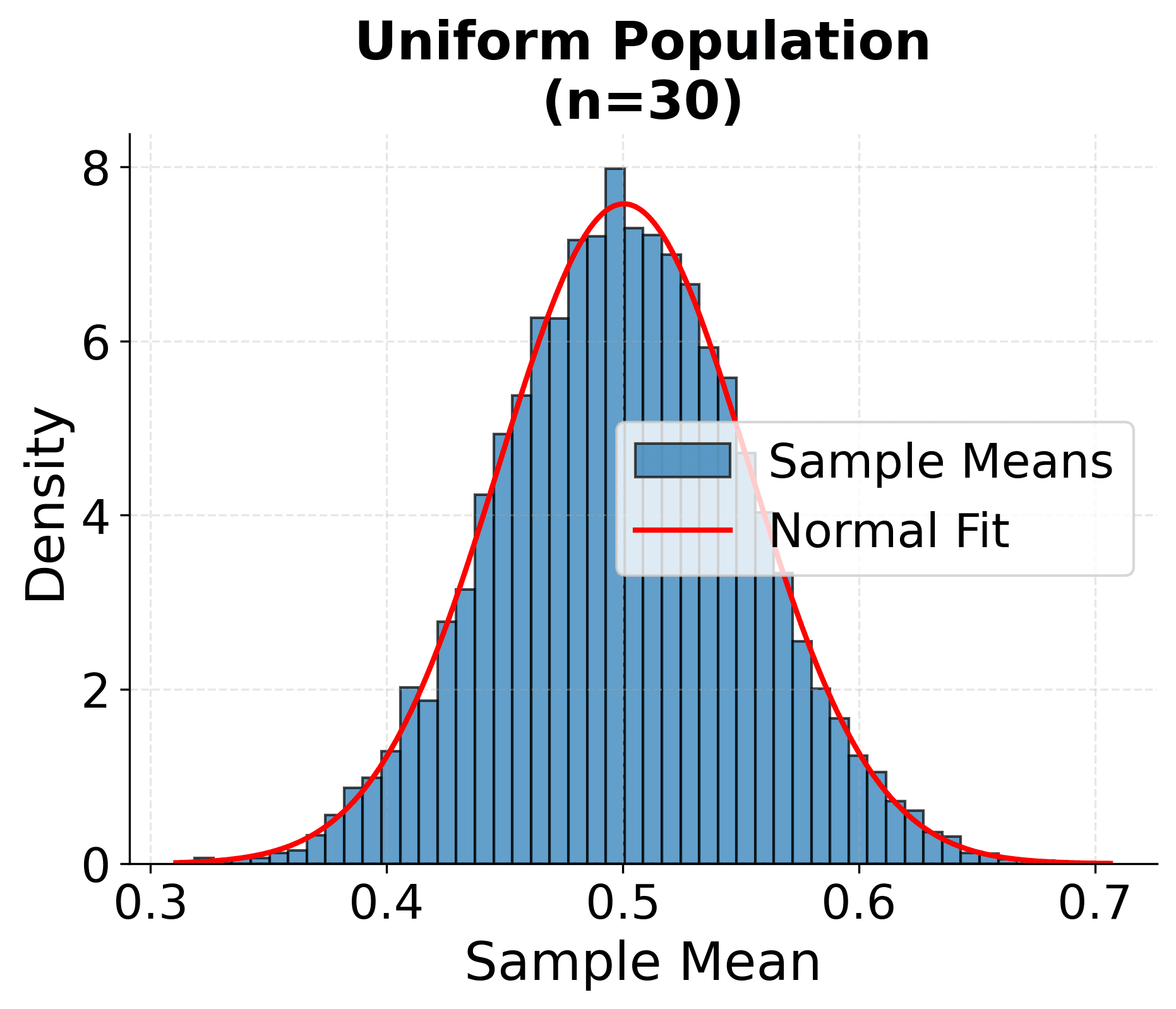
Sample means from uniform population (n=30). The uniform distribution has no skewness, so sample means converge to normality quickly. The resulting distribution is symmetric and bell-shaped, centered at the population mean of 0.5.
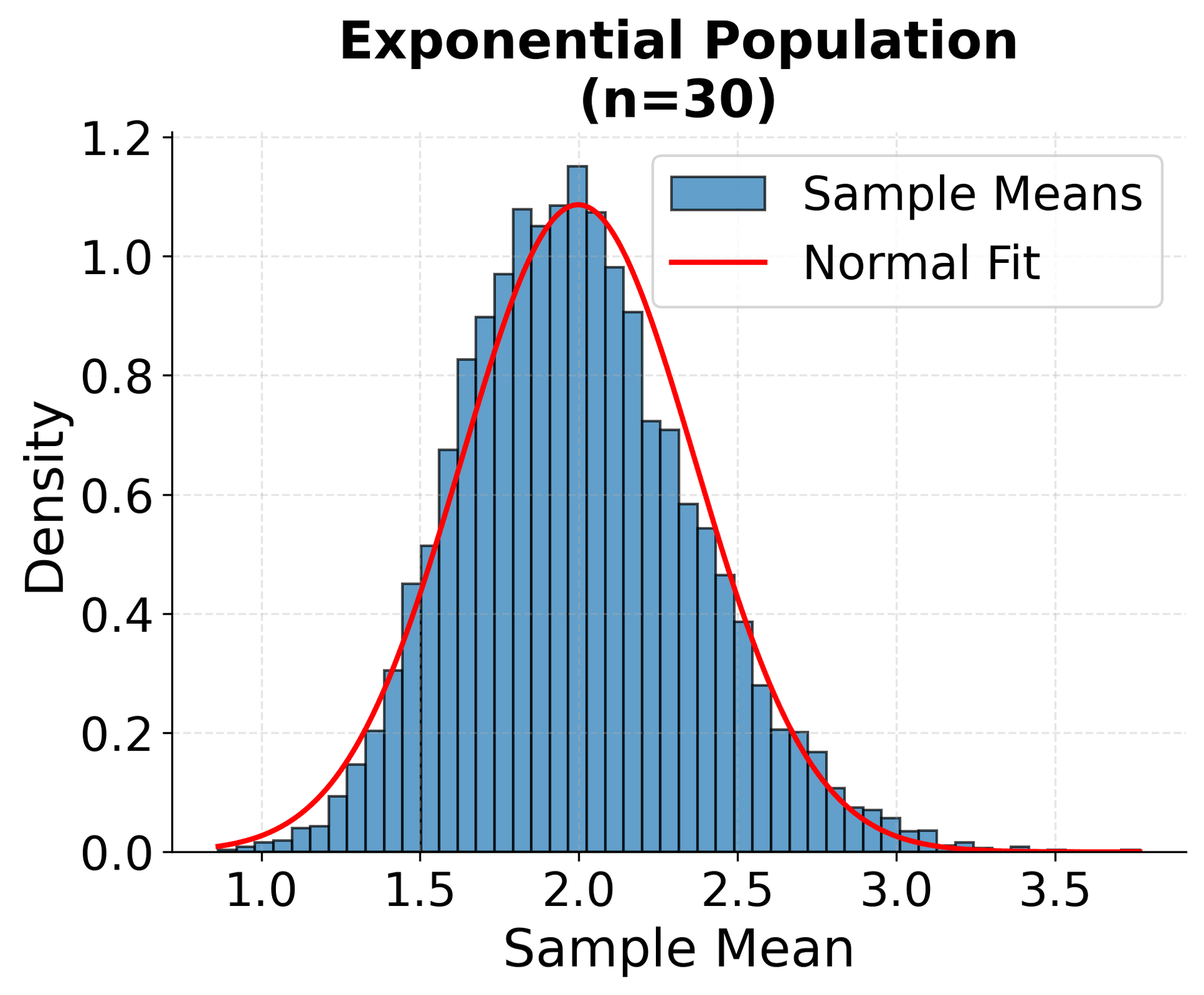
Sample means from exponential population (n=30). Despite the strong right skew in the original distribution, sample means with n=30 show clear convergence to a normal distribution, though slight right skewness may still be detectable.
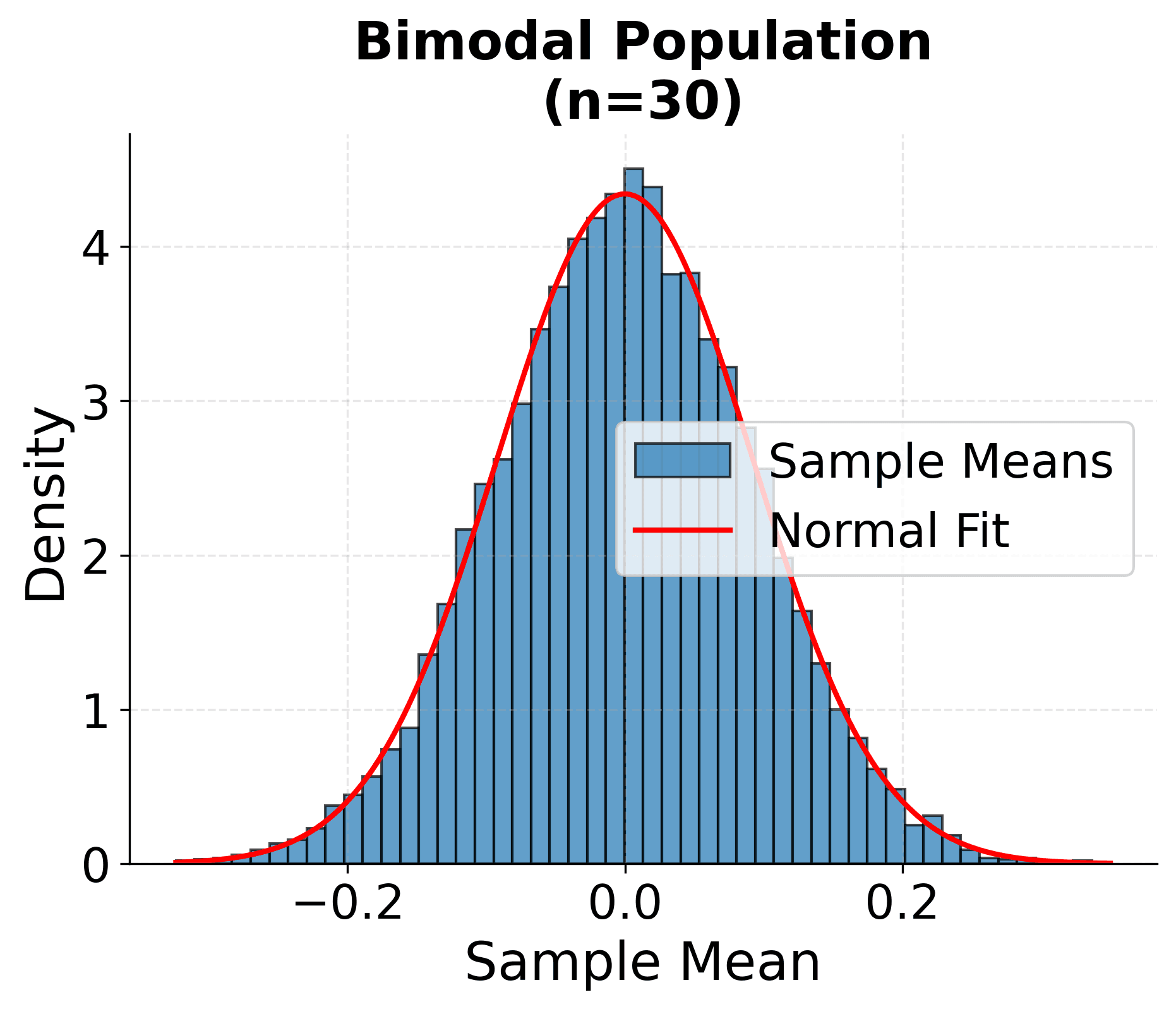
Sample means from bimodal population (n=30). Even with a population that has two distinct peaks, the distribution of sample means becomes unimodal and approximately normal. This demonstrates the remarkable power of the CLT to smooth out complex distributional features.
The Standard Error
A critical component of the Central Limit Theorem is the standard error of the mean, which quantifies the variability of sample means around the population mean. The standard error is defined as:
This formula reveals an important relationship between sample size and precision. Doubling the sample size does not double the precision; rather, it improves precision by a factor of . To cut the standard error in half and achieve twice the precision, we need to quadruple the sample size. This square-root relationship has practical implications for study design and resource allocation in research projects.
In practice, the population standard deviation is typically unknown and must be estimated from the sample using the sample standard deviation . When we substitute for , we obtain the estimated standard error:
The use of the estimated standard error leads to the Student's t-distribution rather than the normal distribution for small samples, but as sample size increases, the t-distribution converges to the normal distribution, consistent with the Central Limit Theorem.
How Large Should n Be?
A common practical question is: how large must the sample size be for the Central Limit Theorem to apply? The answer depends on the shape of the original population distribution. For populations that are already approximately normal, even small sample sizes like or can produce sample means that are approximately normally distributed. For symmetric but non-normal distributions, moderate sample sizes around are typically sufficient.
However, when the population distribution is highly skewed or has heavy tails, larger sample sizes may be required before the sample means converge to normality. In cases of extreme skewness, sample sizes of or more might be necessary. The conventional rule of thumb that is sufficient for the CLT to apply should be viewed as a guideline rather than a hard requirement, and practitioners should consider the shape of their data when determining appropriate sample sizes.
The following example demonstrates how the distribution of sample means becomes increasingly normal as sample size increases, starting from a highly skewed exponential distribution:
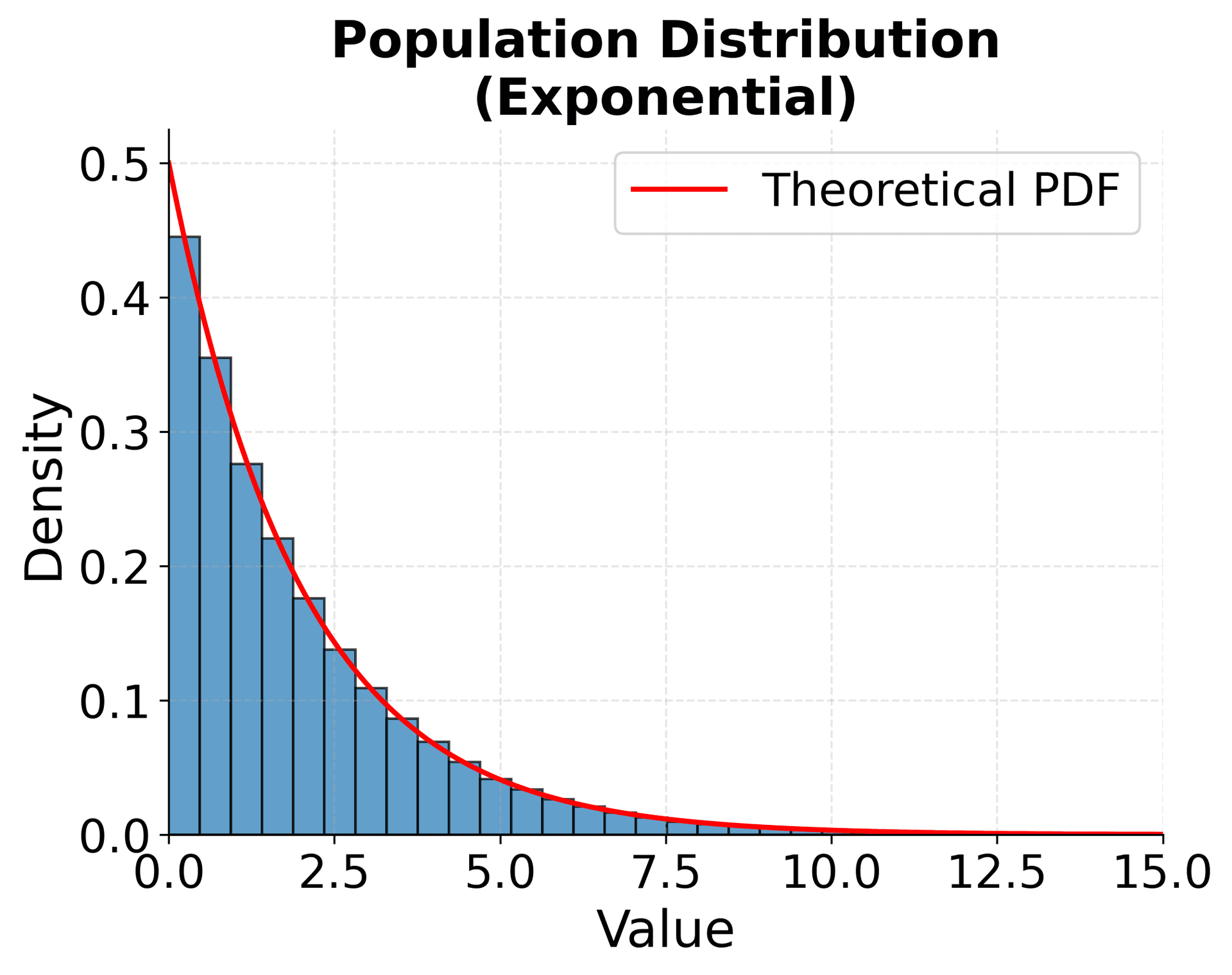
Original exponential population distribution (highly right-skewed). This represents the true underlying distribution from which we draw samples, characterized by a long right tail and concentration of values near zero.
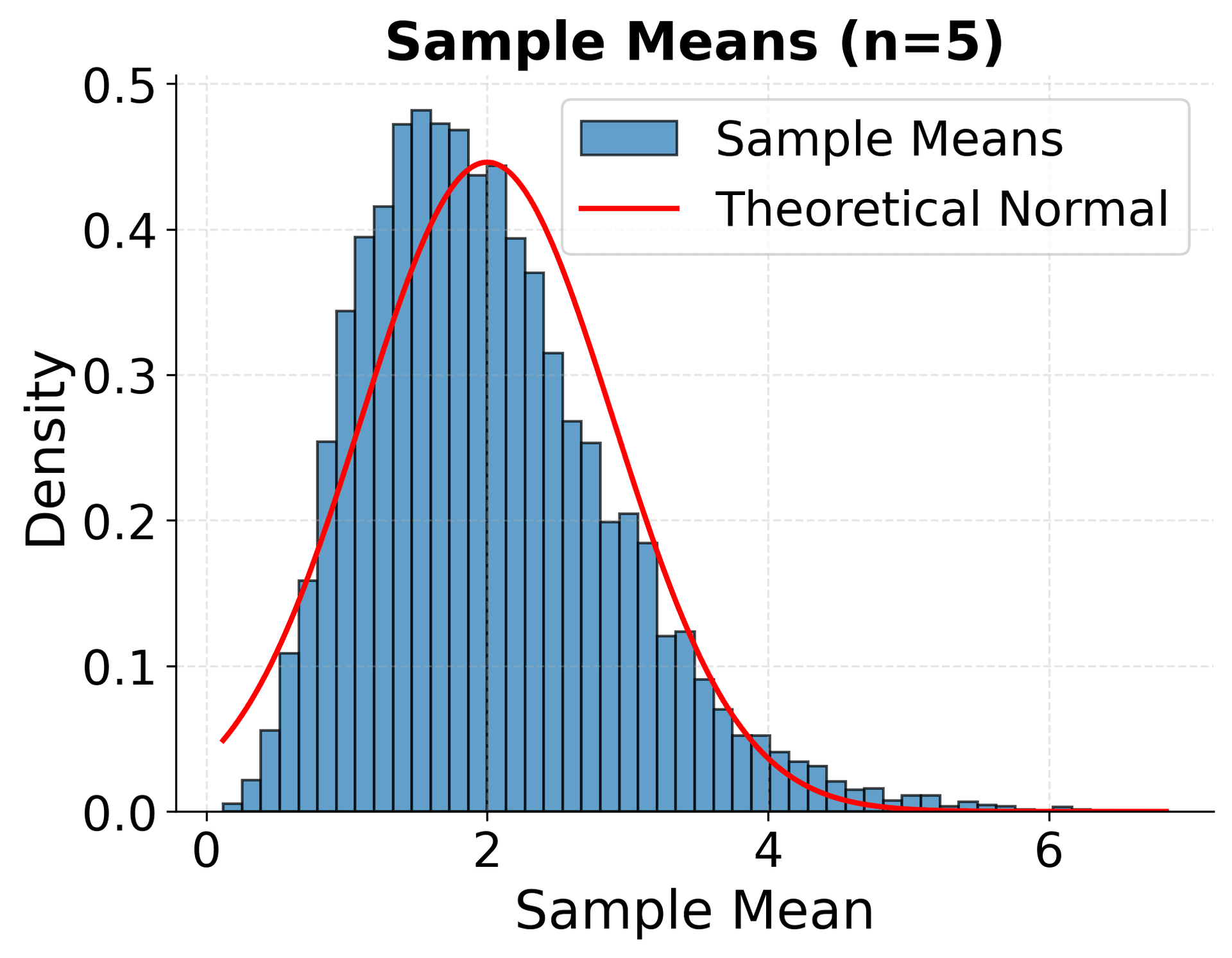
Distribution of sample means with n=5. While the right skew is still visible, the distribution has already begun to shift toward a more symmetric, bell-shaped form. The means are more concentrated around the population mean compared to individual observations.
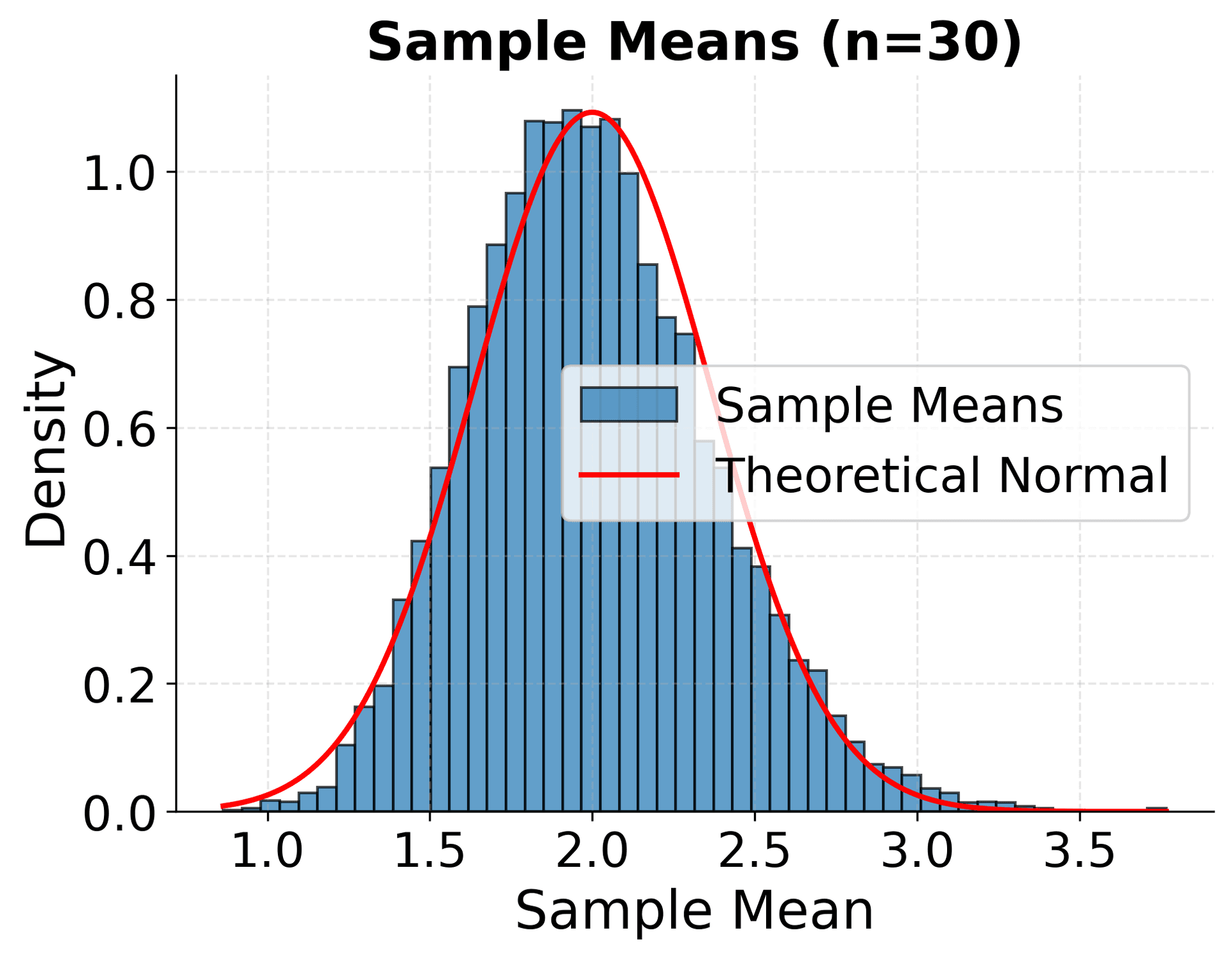
Distribution of sample means with n=30. The distribution now closely approximates a normal distribution despite the original population being exponential. This demonstrates the Central Limit Theorem in action, showing how larger sample sizes produce sample means that converge to normality.
Practical Applications
The Central Limit Theorem enables a wide range of practical statistical applications that data scientists and researchers rely on daily. One of the most common applications is the construction of confidence intervals for population means. When we calculate a sample mean, the CLT tells us that this statistic is approximately normally distributed, allowing us to quantify the uncertainty around our estimate using the standard error and critical values from the normal distribution.
Hypothesis testing relies fundamentally on the Central Limit Theorem. Tests like the z-test and t-test for comparing means assume that test statistics follow known distributions under the null hypothesis. The CLT justifies this assumption even when the underlying data are not normally distributed, provided sample sizes are sufficiently large. This means researchers can test hypotheses about means across diverse fields, from medicine to social sciences to engineering, without requiring that every variable be perfectly normally distributed.
In machine learning and predictive modeling, the CLT underpins methods like bootstrap resampling and cross-validation. When we repeatedly sample from our data to estimate model performance or parameter uncertainty, we rely on the CLT to ensure that our averaged results have predictable statistical properties. The theorem also justifies the use of linear regression with non-normal residuals in large samples, as the coefficient estimates become approximately normal due to their construction as weighted sums of the data.
Quality control and process monitoring in manufacturing provide another important application domain. Control charts that track process means over time depend on the CLT to establish control limits and detect when processes have shifted. By monitoring sample means rather than individual measurements, quality engineers can more reliably identify true process changes while avoiding false alarms caused by natural variability.
Limitations and Considerations
While the Central Limit Theorem is remarkably general and powerful, practitioners must be aware of its limitations and the conditions under which it may not apply. The theorem requires that observations be independent and identically distributed with finite variance. When these assumptions are violated, the convergence to normality may be slow, incomplete, or may not occur at all.
Time series data and clustered observations violate the independence assumption, and applying the CLT directly to such data can lead to incorrect inferences. In these cases, specialized methods that account for dependence structure, such as time series models or hierarchical models, are necessary. Similarly, if the population variance is infinite, as occurs with certain heavy-tailed distributions like the Cauchy distribution, the CLT does not apply in its standard form, and sample means do not converge to a normal distribution.
The practical requirement for "sufficiently large" sample size remains somewhat ambiguous and depends on the population distribution. For highly skewed distributions or those with outliers, practitioners may need much larger samples than the conventional guideline suggests. Visual inspection of the data through histograms or Q-Q plots can help assess whether the sample size is adequate for the approximation to normality to be reasonable.
Additionally, the Central Limit Theorem applies to the distribution of sample means, not to individual observations. A common misconception is that collecting more data will cause the distribution of individual measurements to become normal. The CLT makes no such claim—the original population distribution remains unchanged regardless of sample size. Only the distribution of averages computed from samples converges to normality.
Finally, while the CLT justifies the use of normal-based methods for large samples, practitioners should not rely solely on this theorem when alternative methods are more appropriate. Robust statistical methods, non-parametric tests, and distribution-specific models may provide better inference in cases where the CLT's conditions are questionable or where finite-sample properties are important.
Summary
The Central Limit Theorem stands as one of statistics' most important and elegant results. It tells us that sample means converge to a normal distribution as sample size increases, regardless of the original population distribution, provided the observations are independent with finite variance. This convergence occurs with a standard error that decreases as , meaning that larger samples provide more precise estimates of the population mean.
The theorem's practical importance cannot be overstated. It provides the foundation for confidence intervals, hypothesis tests, and countless statistical procedures used across science, industry, and policy. By ensuring that sample means behave predictably under repeated sampling, the CLT allows us to quantify uncertainty and make probabilistic statements about population parameters based on limited data.
However, practitioners must apply the Central Limit Theorem thoughtfully, considering whether independence assumptions hold, whether sample sizes are adequate given the population distribution, and whether the theorem's asymptotic guarantees are appropriate for the finite samples at hand. When used correctly, the CLT represents a powerful bridge between probability theory and practical data analysis, enabling rigorous statistical inference in a remarkably wide range of applications.
Quiz
Ready to test your understanding of the Central Limit Theorem? Challenge yourself with this quiz covering key concepts, mathematical properties, and practical applications. Good luck!
Reference

About the author: Michael Brenndoerfer
All opinions expressed here are my own and do not reflect the views of my employer.
Michael currently works as an Associate Director of Data Science at EQT Partners in Singapore, where he drives AI and data initiatives across private capital investments.
With over a decade of experience spanning private equity, management consulting, and software engineering, he specializes in building and scaling analytics capabilities from the ground up. He has published research in leading AI conferences and holds expertise in machine learning, natural language processing, and value creation through data.
Related Content

Minimum Cost Flow Slotting: Complete Guide to Network Flow Optimization & Resource Allocation
Learn minimum cost flow optimization for slotting problems, including network flow theory, mathematical formulation, and practical implementation with OR-Tools. Master resource allocation across time slots, capacity constraints, and cost structures.

Mixed Integer Linear Programming (MILP) for Factory Optimization: Complete Guide with Mathematical Foundations & Implementation
Complete guide to Mixed Integer Linear Programming (MILP) for factory optimization, covering mathematical foundations, constraint modeling, branch-and-bound algorithms, and practical implementation with Google OR-Tools. Learn how to optimize production planning with discrete setup decisions and continuous quantities.

CP-SAT Rostering: Complete Guide to Constraint Programming for Workforce Scheduling
Learn CP-SAT rostering using Google OR-Tools to solve complex workforce scheduling problems with binary decision variables, coverage constraints, and employee availability. Master constraint programming for optimal employee shift assignments.
Stay updated
Get notified when I publish new articles on data and AI, private equity, technology, and more.


